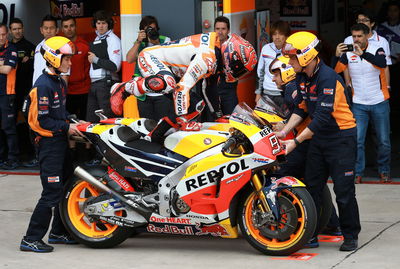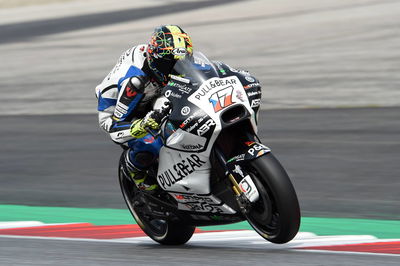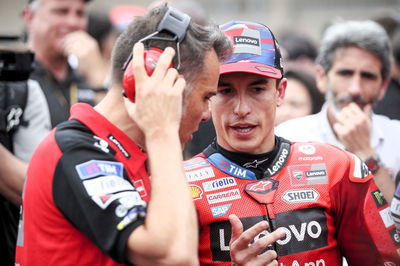F1 'lollipops', bike position next steps for pit safety
The next steps in MotoGP's quest to improve safety during 'flag-to-flag' bike swaps are set to include a 'lollipop man' for rider release and revised bike position in pit lane.
A lower speed limit is also likely, but there are no plans for WorldSBK-style minimum time pit stops, or to favour riders pulling out of their box over those already in pit lane.
"We're doing things we know we can do without making huge problems elsewhere," explained MotoGP Race Director Mike Webb, who listed the planned changes as:

The next steps in MotoGP's quest to improve safety during 'flag-to-flag' bike swaps are set to include a 'lollipop man' for rider release and revised bike position in pit lane.
A lower speed limit is also likely, but there are no plans for WorldSBK-style minimum time pit stops, or to favour riders pulling out of their box over those already in pit lane.
"We're doing things we know we can do without making huge problems elsewhere," explained MotoGP Race Director Mike Webb, who listed the planned changes as:
"Fewer people in pit lane, a dedicated person ['lollipop man'] for bike release and all work on the bikes being done inside the garage.
"Those are steps that don't hurt anything else and should help."
With just one week between Brno - where Andrea Iannone fell in pit lane after Aleix Espargaro pulled out in front of him - and Austria, an immediate proposal was to cut the pit-lane speed limit from 60 to 40km/h in future races.
"The lower speed actually came to a very quick end because the factory engineers reported back from headquarters and said, 'our engines won't run at that speed'," Webb said. "So we are now waiting on information from all of the factories about what is the minimum speed we could impose inside the technical possibilities."
While lowering the speed would do no harm, it also wouldn't make much difference to the biggest danger.
"Where it's most dangerous - where the bikes are crossing - the riders are already going slower than the maximum speed anyway. A lower speed will probably help, but it's not the cure."
The focus has instead been on "tweaking what we've got, rather than trying to reinvent the whole thing", while being careful to avoid replacing one problem with another.
"Every single change that's suggested has good and bad points. On paper, we had some brilliant reinventions to cure the crossover of bikes, but they added significant new problems."
If the crossover is the most dangerous moment, the people most at risk when it goes wrong are those working outside the garages, wearing far less safety protection than the riders.
"We have leathers and helmets, but if the bike hits a mechanic… it can be a disaster," said Aleix Espargaro.
"The key thing is to move as many people out of pit lane as possible," Webb declared.
"We want to do the bike change right up against the box - virtually at the entrance to the box - and demand that all work done on the spare bike is done inside the box.
"Tyre changing, bike adjustment, repairs - whatever currently goes on in pit lane gets transferred to the box and when the bike is ready it can be wheeled out right in front of the box, where the bike change will occur.
"The only thing you will be able to do in pit lane is take the tyre warmers off and start the bike.
"And to me the major one is a dedicated person for bike release, like in Formula One.
F1-style 'lollipop' signs are set to be used to improve safety during MotoGP bike swaps #MotoGP pic.twitter.com/qWzfBukyi6
— CRASH.NET MotoGP (@crash_motogp) August 21, 2017
"A 'lollipop' [sign] in front of you; you can't go until that bloke says so and his only job is to look for oncoming bikes. Nothing else. He is not holding a bike, not taking a tyre warmer off, he's only got one responsibility."
Interestingly, by drawing the possible turn-in and exit path for each rider, Race Direction believes the 'lollipop man' will only have three riders to watch out for.
"When you draw it out, the person doing the safe release only has to pay attention to three possible riders coming in and crossing their path," Webb said. "The danger area is actually quite small.
"Each [lollipop man], once they get used to the system, will know: 'My nearest three neighbours are the only ones that can possibly cross my rider's exit path'.
"They don’t need to worry about riders who will be stopping a lot earlier or a lot later in pit lane, because those riders should be continuing in a straight line on the fast side of pit lane. So their rider can leave the box and blend-in alongside them when they are released."
The fact that each rider waiting to depart only (theoretically) needs to give way to a maximum of three riders was also one of the reasons why it was decided not to give priority to riders leaving the pit box.
"We listen to the riders a lot. Probably more than any other sport. But with 10 riders you'll get 15 different opinions! So at some point we have to say, this is sensible or this is workable and this is what we're doing," Webb said.
"The riders have the feeling that someone who is first in to change their bike should have priority going out. But I'm sorry; you can stop a bike from leaving, but if you stop the person coming in - in the middle of pit lane - that creates even more problems and is virtually unmanageable.
"Part of the riders' concern is, 'what if there is a sudden shower and everyone comes in together; the first rider in, if they happen to be in the first pit box, then has to wait for the entire field to go past before they can leave'.
"It's a valid worry - that doesn't happen often - but as I've said, the bike at the start of pit lane would only have three specific bikes to worry about potentially crossing its path, not all 22 bikes.
" The other [19 bikes] are a 'blend' situation and should stay on the fast side of pit lane. It's like a motorway entrance ramp and also what they do every week in qualifying; having changed their tyre they head back out and blend-in beside the rider who is either coming in or going out."
There has also been some discussion about changing the angle at which the rider parks his first bike and re-joins on the second bike.
"What's been circulated to teams said, 'you will come in on a 45-degree angle and the bike waiting to go will be at 45-degrees'," Webb confirmed. "Those are details that are yet to be [agreed]. We may find that it's not ideal. A MotoGP bike, especially on slicks in a wet pit lane, can't make a sharp turn. So there has to be an ideal angle.
"There will also be a marker on the pit wall that the rider can see to know their ideal turn-in point for their box. So they are not looking around trying to find their box. That is also something that will make it a bit easier for everyone."
Some riders had backed the introduction of a WorldSBK-style system, where a minimum time is given from pit entry to pit exit, reducing the need to rush during bike changeover.
"Talking to the people in Superbike, some were saying it doesn't cure the problem because you've still got bike crossover and the riders still do the pit-stop quickly, but then wait at the end of pit lane to be first back out on track," Webb said.
"There is some benefit to having the panic of changeover reduced, but the overall consensus was it's definitely not a 'cure'... There is a desire to try and improve what we've got in MotoGP, without changing it completely."
Spreading the MotoGP garages out along pit lane, perhaps by placing a Moto2 or Moto3 team in-between, was another proposal.
"It sounds really easy, but there are a load of small reasons that make it hard. Just simple space, for example. It can't currently be done in a fair way to all MotoGP teams, someone would always not have that extra space.
"So these small steps together - fewer people in pit lane, dedicated person for bike release and work on the bikes being done inside the garage - is what we are going to try and get."
Webb highlighted that flag-to-flag (not stopping a race due to weather changes) has been in place since 2007, with very few pit-lane incidents and no serious injuries.
But the perception at least is that riders are pushing harder than before in pit lane, ramping up the danger.
"There is so much time to be made in pitlane and riders are only just realising that. That's why now there are more crashes," said Scott Redding. "You can make seconds in pitlane and tenths out on the circuit. It's easy seconds."












